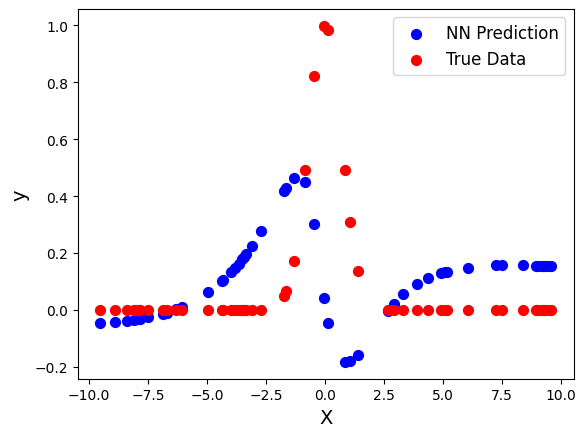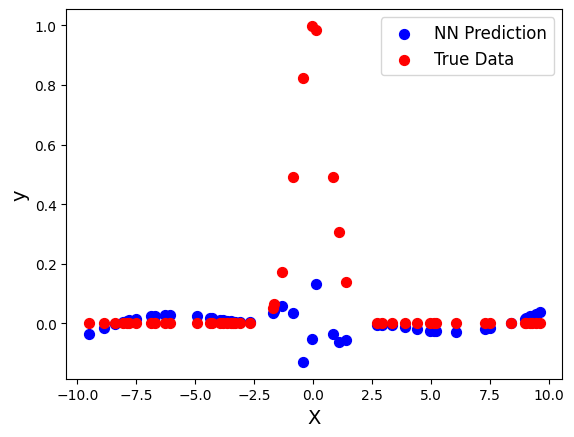# IMPORTS
# Math for the ceiling function
from math import ceil
# Matplotlib for graphing capabilities
from matplotlib import pyplot as plt
# Numpy for arrays
import numpy as np
# Modules from the JAX library for creating neural networks
import jax.numpy as jnp
from jax import grad
from jax import random as nprCreating Neural Networks from Scratch
CSC/DSC 340 Week 9 Slides
Author: Dr. Julie Butler
Date Created: October 16, 2023
Last Modified: October 16, 2023
- This week we will learn how to create neural networks from scratch, using the Python library JAX to perform the optimization.
- Another common library for this task is autograd but it is no longer being maintained
Review of Neural Network Equations
- A return to Week 7 Slides
Creating a Neural Network from Scratch Using JAX
- JAX is an automatic differentiation library in Python that can find the derivative of any chunk of code it is given.
- If you are interested you can read more about the library here.
Generate the Data Set
Let’s keep things simple and generate a data points from a Gaussian curve. We will have our x data be evenly space between -10 and 10 and our y data be the corresponding points on a Gaussian curve.
# Let's create a data set that is just a basic Gaussian curve
X = np.linspace(-10,10,250)
y = np.exp(-X**2)Perform a Train-Test Split
# We will split the data set into two pieces, a training data set that contains
# 80% of the total data and a test set that contains the other 20%
from sklearn.model_selection import train_test_split
train_size = 0.8
X_train, X_test, y_train, y_test = train_test_split(X, y, train_size=train_size)Define the Neural Network
First we will define the sigmoid function as our activation function.
def sigmoid(x):
"""
Calculates the value of the sigmoid function for
a given input of x
"""
return 1. / (1. + jnp.exp(-x))- Now we will define our neural network.
- Here we will be using an architecture with two hidden layers, each using the sigmoid activation function, and an output layer which does not have an activation function.
- Note that we do not use the bias offset in this code
def neural_network(W, x):
"""
Inputs:
W (a list): the weights of the neural network
x (a float): the input value of the neural network
Returns:
Unnamed (a float): The output of the neural network
Defines a neural network with one hidden layer. The number of neurons in
the hidden layer is the length of W[0]. The activation function is the
sigmoid function on the hidden layer an none on the output layer.
"""
# Calculate the output for the neurons in the hidden layers
hidden_layer1 = sigmoid(jnp.dot(x,W[0]))
hidden_layer2 = sigmoid(jnp.dot(hidden_layer1, W[1]))
# Calculate the result for the output neuron
return jnp.dot(hidden_layer2, W[2])Define the Loss Function
Now we need to define our loss function. For simplicity we will be using the mean-squared error loss function, which is a very common loss function for training neural networks.
def loss_function(W, x, y):
"""
Inputs:
W (a list): the weights of the neural network
t (a 1D NumPy array): the times to calculate the predicted position at
Returns:
loss_sum (a float): The total loss over all times
The loss function for the neural network to solve for position given
a function for acceleration.
"""
# Define a variable to hold the total loss
loss_sum = 0.
# Loop through each individual time
for i in range(len(x)):
# Get the output of the neural network with the given set of weights
nn = neural_network(W, x[i])[0][0]
err_sqr = (nn-y[i])**2
# Update the loss sum
loss_sum += err_sqr
loss_sum /= len(x)
# Return the loss sum
return loss_sumTrain the Neural Network
- Finally we need to train our neural network.
- We will start by randomly initializing the weights of our neural network (with 25 neurons per hidden layer).
# Generate the key for the random number generator
key = npr.PRNGKey(0)
# Set the number of neurons in the hidden layer
number_hidden_neurons = 25
# Initialize the weights of the neural network with random numbers
W = [npr.normal(key,(1, number_hidden_neurons)),
npr.normal(key,(number_hidden_neurons,number_hidden_neurons)),
npr.normal(key,(number_hidden_neurons, 1))]- We then define the parameters for the learning rate, the number of training iterations, and the threshold for stopping the training.
# Set the learning rate and the number of training iterations for the network
learning_rate = 0.01
num_training_iterations = 100
threshold = 0.0001
previous_loss = 0- Next, we perform gradient descent to update the weights of the neural network over for the set number of training iterations, or until the loss function value converges to some set threshold.
WARNING: This cell will take a long time to run.
# Train the neural network for the specified number of iterations
# Update the weights using the learning rates
for i in range(num_training_iterations):
print("Training Iteration:", i+1)
current_loss = loss_function(W,X_train,y_train)
print("Loss:", current_loss)
print()
# If the current loss is within a set threshold of the previous loss, stop
# the training
if np.abs(current_loss-previous_loss) < threshold:
break;
# Calculate the gradient of the loss function and then use that gradient to
# update the weights of the neural network using the learning rate and the
# gradient descent optimization method
loss_grad = grad(loss_function)(W, X_train, y_train)
# Update first hidden layer
W[0] = W[0] - learning_rate * loss_grad[0]
# Update second hidden layer
W[1] = W[1] - learning_rate * loss_grad[1]
# Update output layer
W[2] = W[2] - learning_rate * loss_grad[2]
previous_loss = current_lossTraining Iteration: 1
Loss: 5.7393837
Training Iteration: 2
Loss: 3.9249494
Training Iteration: 3
Loss: 2.7430646
Training Iteration: 4
Loss: 1.9642867
Training Iteration: 5
Loss: 1.4439908
Training Iteration: 6
Loss: 1.0908564
Training Iteration: 7
Loss: 0.8469455
Training Iteration: 8
Loss: 0.6752586
Training Iteration: 9
Loss: 0.5519808
Training Iteration: 10
Loss: 0.46164405
Training Iteration: 11
Loss: 0.39409688
Training Iteration: 12
Loss: 0.34260026
Training Iteration: 13
Loss: 0.30262083
Training Iteration: 14
Loss: 0.2710642
Training Iteration: 15
Loss: 0.24578558
Training Iteration: 16
Loss: 0.22527163
Training Iteration: 17
Loss: 0.20843603
Training Iteration: 18
Loss: 0.1944845
Training Iteration: 19
Loss: 0.18282592
Training Iteration: 20
Loss: 0.17301211
Training Iteration: 21
Loss: 0.16469756
Training Iteration: 22
Loss: 0.15761234
Training Iteration: 23
Loss: 0.1515421
Training Iteration: 24
Loss: 0.14631484
Training Iteration: 25
Loss: 0.14179125
Training Iteration: 26
Loss: 0.13785718
Training Iteration: 27
Loss: 0.13441862
Training Iteration: 28
Loss: 0.13139778
Training Iteration: 29
Loss: 0.12872973
Training Iteration: 30
Loss: 0.12636037
Training Iteration: 31
Loss: 0.12424435
Training Iteration: 32
Loss: 0.12234331
Training Iteration: 33
Loss: 0.12062525
Training Iteration: 34
Loss: 0.119062945
Training Iteration: 35
Loss: 0.1176336
Training Iteration: 36
Loss: 0.11631781
Training Iteration: 37
Loss: 0.11509922
Training Iteration: 38
Loss: 0.113963954
Training Iteration: 39
Loss: 0.11290028
Training Iteration: 40
Loss: 0.11189827
Training Iteration: 41
Loss: 0.11094945
Training Iteration: 42
Loss: 0.110046774
Training Iteration: 43
Loss: 0.10918406
Training Iteration: 44
Loss: 0.10835604
Training Iteration: 45
Loss: 0.1075586
Training Iteration: 46
Loss: 0.10678794
Training Iteration: 47
Loss: 0.10604083
Training Iteration: 48
Loss: 0.105314724
Training Iteration: 49
Loss: 0.10460715
Training Iteration: 50
Loss: 0.10391628
Training Iteration: 51
Loss: 0.103240326
Training Iteration: 52
Loss: 0.10257807
Training Iteration: 53
Loss: 0.10192816
Training Iteration: 54
Loss: 0.10128962
Training Iteration: 55
Loss: 0.10066156
Training Iteration: 56
Loss: 0.10004312
Training Iteration: 57
Loss: 0.09943377
Training Iteration: 58
Loss: 0.098832875
Training Iteration: 59
Loss: 0.098239936
Training Iteration: 60
Loss: 0.0976546
Training Iteration: 61
Loss: 0.097076416
Training Iteration: 62
Loss: 0.09650502
Training Iteration: 63
Loss: 0.09594035
Training Iteration: 64
Loss: 0.09538187
Training Iteration: 65
Loss: 0.09482949
Training Iteration: 66
Loss: 0.09428306
Training Iteration: 67
Loss: 0.09374238
Training Iteration: 68
Loss: 0.09320727
Training Iteration: 69
Loss: 0.09267756
Training Iteration: 70
Loss: 0.09215312
Training Iteration: 71
Loss: 0.091633804
Training Iteration: 72
Loss: 0.09111967
Training Iteration: 73
Loss: 0.090610415
Training Iteration: 74
Loss: 0.09010603
Training Iteration: 75
Loss: 0.08960638
Training Iteration: 76
Loss: 0.08911151
Training Iteration: 77
Loss: 0.08862111
Training Iteration: 78
Loss: 0.08813539
Training Iteration: 79
Loss: 0.087654
Training Iteration: 80
Loss: 0.087177046
Training Iteration: 81
Loss: 0.08670438
Training Iteration: 82
Loss: 0.08623596
Training Iteration: 83
Loss: 0.08577179
Training Iteration: 84
Loss: 0.08531174
Training Iteration: 85
Loss: 0.084855735
Training Iteration: 86
Loss: 0.08440378
Training Iteration: 87
Loss: 0.08395572
Training Iteration: 88
Loss: 0.08351156
Training Iteration: 89
Loss: 0.08307134
Training Iteration: 90
Loss: 0.08263482
Training Iteration: 91
Loss: 0.08220212
Training Iteration: 92
Loss: 0.08177301
Training Iteration: 93
Loss: 0.08134764
Training Iteration: 94
Loss: 0.08092584
Training Iteration: 95
Loss: 0.08050759
Training Iteration: 96
Loss: 0.080092885
Training Iteration: 97
Loss: 0.07968161
Training Iteration: 98
Loss: 0.07927379
Training Iteration: 99
Loss: 0.07886927
Training Iteration: 100
Loss: 0.078468055
Analyze the Results
Now we need to analyze the performance of our neural network using the test data set that was reserved earlier. First we need to generate the neural network predictions for the y component of the test data set.
y_nn = [neural_network(W, xi)[0][0] for xi in X_test] First lets analyze the results graphically by plotting the predicted test data set and the true test data set on the same graph.
plt.scatter(X_test, y_nn, s=50, color="blue",label="NN Prediction")
plt.scatter(X_test, y_test, s=50, color="red", label="True Data")
plt.legend(fontsize=12)
plt.xlabel("X",fontsize=14)
plt.ylabel("y",fontsize=14)Text(0, 0.5, 'y')
Next let’s analyze the error numerically using the root mean-squared error (RMSE) function, which is simiply the square root of the mean-squared error. The RMSE gives the average error on each data point (instead of the squared average error) so it is a met more of a clear metric for error analysis. First, let’s define a function to calculate the RMSE between two data sets.
def rmse(A,B):
"""
Inputs:
A,B (NumPy arrays)
Returns:
Unnamed (a float): the RMSE error between A and B
Calculates the RMSE error between A and B.
"""
assert len(A)==len(B),"The data sets must be the same length to calcualte\
the RMSE."
return np.sqrt(np.average((A-B)**2))
Now let’s print the RMSE between the true test data set and the neural network prediction.
print("RMSE between true test set and neural network result:", rmse(y_nn,y_test))RMSE between true test set and neural network result: 0.28406674843753915